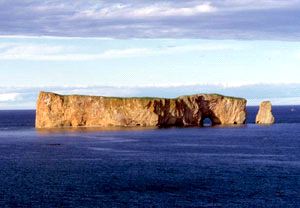Devonian lands in the Gaspé Peninsula
A quick glance at Quebec’s geological maps reveals the considerable importance of the Devonian Period in the Gaspé region.
 (12 kb) The famous Forillon Peninsula and Percé Rock are but small tips of the vast areas of Devonian rocks that occupy the interior. Known to the world since 1844 thanks to the exploratory expeditions of Sir William Edmond Logan, the father of Canadian geology, the importance of these rocks was underscored by the work of American geologist John M. Clarke who used them as reference sections in his 1908 monograph Early Devonic History of New York and Eastern North America. At that time, the wealth of the “Scaumenac layers” at Miguasha became clear, and they were heralded as a jewel of the Devonian.
(12 kb) The famous Forillon Peninsula and Percé Rock are but small tips of the vast areas of Devonian rocks that occupy the interior. Known to the world since 1844 thanks to the exploratory expeditions of Sir William Edmond Logan, the father of Canadian geology, the importance of these rocks was underscored by the work of American geologist John M. Clarke who used them as reference sections in his 1908 monograph Early Devonic History of New York and Eastern North America. At that time, the wealth of the “Scaumenac layers” at Miguasha became clear, and they were heralded as a jewel of the Devonian.

 (88 kb)Devonian rocks in the Gaspé represent the entire time period and document a great variety of animal and plant communities from land and sea habitats alike. The rocks mostly occupy the region’s east-west axis, and are contained within a large geological structure that extends beyond Quebec into Vermont and Maine. This weakly folded rock structure is known as the Gaspé Synclinorium. It is also commonly referred to as the Gaspé Basin because it represents great accumulations of ancient sea deposits.
(88 kb)Devonian rocks in the Gaspé represent the entire time period and document a great variety of animal and plant communities from land and sea habitats alike. The rocks mostly occupy the region’s east-west axis, and are contained within a large geological structure that extends beyond Quebec into Vermont and Maine. This weakly folded rock structure is known as the Gaspé Synclinorium. It is also commonly referred to as the Gaspé Basin because it represents great accumulations of ancient sea deposits.
R. Hugh W. Ells, Logan’s right hand man and the one who rediscovered the fossils of the “Scaumenac Bay layers” at Miguasha, was the first geologist to pursue the Devonian rock beds by canoe and across mountains. His results were published as the first geological maps of the Gaspé interior in 1884.

 (12 kb) The famous Forillon Peninsula and Percé Rock are but small tips of the vast areas of Devonian rocks that occupy the interior. Known to the world since 1844 thanks to the exploratory expeditions of Sir William Edmond Logan, the father of Canadian geology, the importance of these rocks was underscored by the work of American geologist John M. Clarke who used them as reference sections in his 1908 monograph Early Devonic History of New York and Eastern North America. At that time, the wealth of the “Scaumenac layers” at Miguasha became clear, and they were heralded as a jewel of the Devonian.
(12 kb) The famous Forillon Peninsula and Percé Rock are but small tips of the vast areas of Devonian rocks that occupy the interior. Known to the world since 1844 thanks to the exploratory expeditions of Sir William Edmond Logan, the father of Canadian geology, the importance of these rocks was underscored by the work of American geologist John M. Clarke who used them as reference sections in his 1908 monograph Early Devonic History of New York and Eastern North America. At that time, the wealth of the “Scaumenac layers” at Miguasha became clear, and they were heralded as a jewel of the Devonian. 
 (88 kb)Devonian rocks in the Gaspé represent the entire time period and document a great variety of animal and plant communities from land and sea habitats alike. The rocks mostly occupy the region’s east-west axis, and are contained within a large geological structure that extends beyond Quebec into Vermont and Maine. This weakly folded rock structure is known as the Gaspé Synclinorium. It is also commonly referred to as the Gaspé Basin because it represents great accumulations of ancient sea deposits.
(88 kb)Devonian rocks in the Gaspé represent the entire time period and document a great variety of animal and plant communities from land and sea habitats alike. The rocks mostly occupy the region’s east-west axis, and are contained within a large geological structure that extends beyond Quebec into Vermont and Maine. This weakly folded rock structure is known as the Gaspé Synclinorium. It is also commonly referred to as the Gaspé Basin because it represents great accumulations of ancient sea deposits.R. Hugh W. Ells, Logan’s right hand man and the one who rediscovered the fossils of the “Scaumenac Bay layers” at Miguasha, was the first geologist to pursue the Devonian rock beds by canoe and across mountains. His results were published as the first geological maps of the Gaspé interior in 1884.
Site map | Feedback | Links | Sources | Credits
Devonian lands in the Gaspé Peninsula
<< Faunal realms | The Miguasha Group >>

Title: Percé Rock
Author: Jean-Pierre Huard
Sources: Parc national de l’Île-Bonaventure-et-du-Rocher-Percé
Year: 2004
Description:
Percé Rock – a symbol of the Devonian Period in the Gaspé region. Its fossil-rich subvertical beds belong to the Forillon Formation, which is in the lower part of the geological Upper Limestone Gaspé Group of Lower Devonian age (Praguian).



